-
TrimSL AWD
-
Engine2.0 L I4
-
Power176 HP (system peak), 141 HP (gas), 40 HP (electric) / 144 LB-FT (gas). 118 LB-FT (electric)
-
TransmissionCVT
-
DrivetrainFront- or All-Wheel Drive
-
Engine PlacementFront
-
Curb Weight3,814 LBS (SL AWD)
-
Seating2 + 3
-
Cargo27.3 CU FT
-
MPG31City / 34 HWY (AWD), 33 City / 35 HWY (FWD)
-
As Tested Price$35,000 (est)
It is perhaps fitting that Nissan has linked up with Lucasfilm to create the Rogue One Star Wars Limited Edition Rogue crossover. Not because that collaboration makes any sense beyond the shared words, but because both companies have shown that they can take a good idea and miss on the execution. It was that way with Episode I: A Phantom Menace and the same is true for the 2017 Nissan Rogue Hybrid.
Okay, maybe we're not as big of fans of Nissan's compact crossover as we are of the Star Wars franchise, but the standard Rogue is plenty competent and is now more competitive with a refresh for 2017. That's why the new hybrid model – a first for this compact crossover – had us expecting a welcome addition to the lineup. It seemed like a can't-lose proposition, but instead it has us thinking more of the pod races, midichlorians, and wooden acting that dragged down the highly anticipated Star Wars reboot.
The Rogue Hybrid's stats aren't the problem. Nissan paired a 141-horsepower, 144-pound-foot 2.0-liter, naturally aspirated four-cylinder with a 30-kilowatt electric motor for net output of 176 hp. That's more power than the 2.5-liter gas-only model. It sounds great on paper.
The two-clutch hybrid system sounds nice, too. Fitting one clutch between the engine and the electric motor and another between the motor and the Xtronic continuously variable transmission lets the engine shut down during highway driving and while coasting. In the gas engine's stead, the electric motor and the quick-charging lithium-ion battery pick up the slack and yield improved fuel economy.
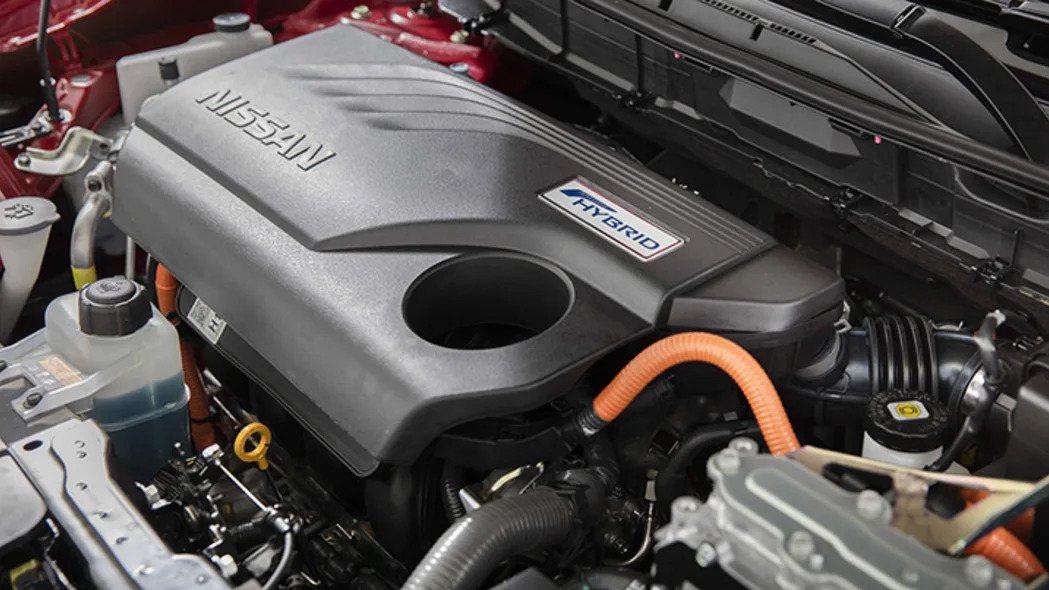
But the two clutches suffer from what we'll call bad directing. The Rogue Hybrid's constant cycling between the gas engine and electric motor brings the powertrain's disagreements to the forefront. By contrast, the gas-electric Rogue's only natural rival, the Toyota RAV4 Hybrid, uses a planetary gearset to seamlessly integrate engine and electric motor, making shifts in power source easy to ignore. You can't ignore the Rogue's juggling.
Dig into the throttle from a standstill, and a half-second later the electric motor and gas engine start squabbling about where the power should come from. At first it seems like a laggy throttle, but after a short while you realize the issue isn't as simple as poor throttle calibration – it feels like the engine and motor are reading different chapters of different books in different libraries. Once the Rogue gets around to moving, things improve.
The Rogue Hybrid's actual performance under load is pleasant. There's almost enough low-end torque to make up for the sluggish off-the-line behavior, and when you're hard on the throttle it provides similar performance to the standard model, despite the extra 200 pounds of hybrid powertrain onboard. But back off, and things go to pieces again.
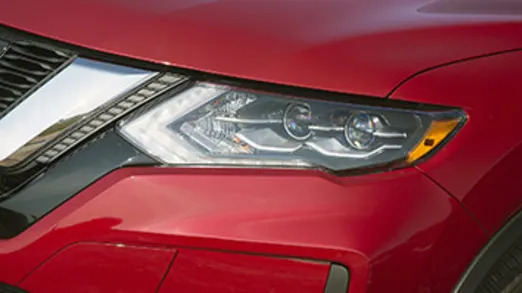

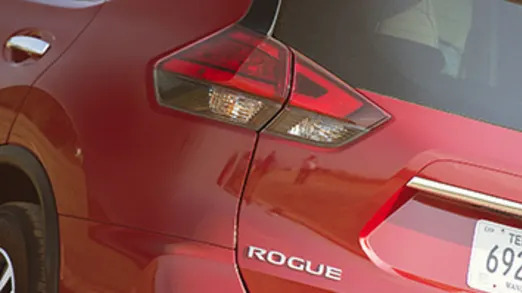
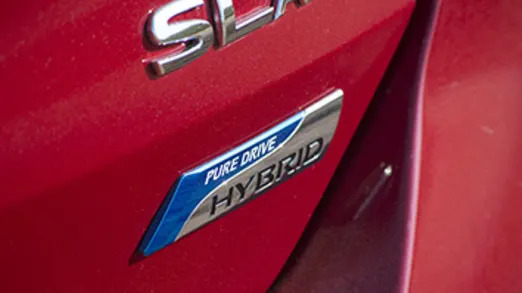
Sure, the hybrid system is geared toward returning good fuel economy – Nissan estimates RAV4-besting highway and combined ratings. But it does this by shutting off the engine at every constant-throttle opportunity it gets. Cruising on a country lane? Engine off. Freeway slog? Engine off again. Crawling through a neighborhood? You guessed it. The electric motor picks up the slack in light-throttle situations – the Rogue Hybrid will run on electric power alone at up to 75 miles per hour or for two full minutes at 25 mph – but digging deeper into the throttle forces the gas engine to fire up again.
This is typical hybrid behavior, but the Rogue's execution lacks polish. In the RAV4, you barely notice this happening. When you step on the gas in the Rogue, the lack of activity makes it seem like there is something wrong. There isn't – it's just the powertrain trying to figure out what the driver wants. If Nissan could speed up the four-cylinder's restart procedure, that might improve things. But as it stands, the constant sensation of being left flatfooted is annoying and, initially, worrying.
As with any hybrid, this Rogue uses regenerative braking to recapture energy, and it's here we observe an issue that we also noted with the Pathfinder Hybrid's brakes: they're grabby and difficult to modulate. Like with the Pathfinder, the unnatural reactions aren't a deal breaker – especially relative to the powertrain issues – but other automakers have managed to find a better balance between brake regen and modulation.
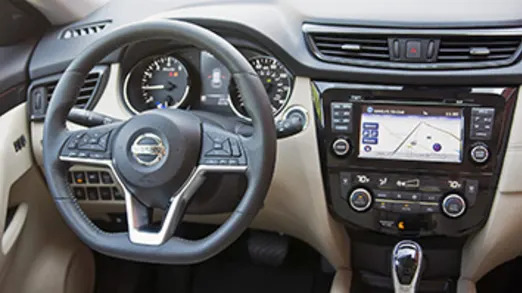
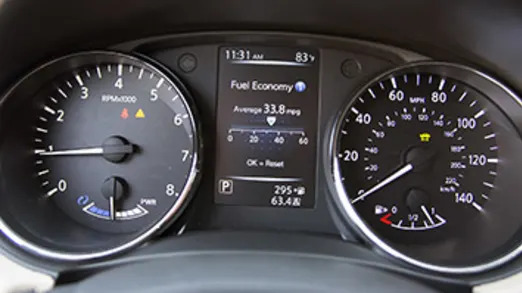
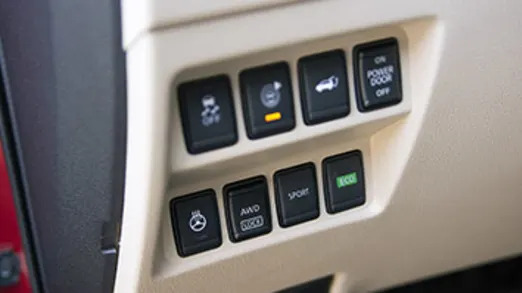
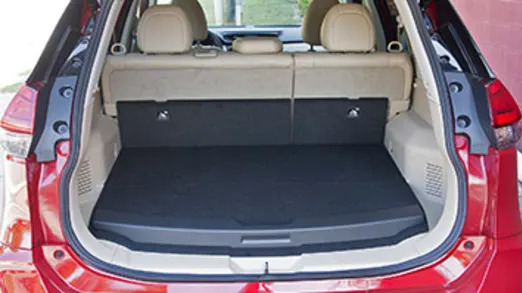
But there's that fuel economy again. Depending on how the numbers shake out in EPA testing, the Rogue could be the most fuel-efficient compact crossover from a mainstream automaker, a title currently held by the all-wheel-drive-only RAV4 Hybrid's 32-mile-per-gallon combined rating (34 city and 30 highway). Nissan estimates the front-drive Rogue Hybrid will return 33 mpg city and 35 highway for a 34-mpg combined rating. All-wheel drive drops those figures to 31, 34, and 33, respectively. So yes, the Rogue would barely win, but not when comparing the all-wheel-drive models.
We will of course admit that Episode I wasn't without its redeeming qualities, and that's true of the Rogue Hybrid. But unlike the stunning visuals in The Phantom Menace that set it apart from the original Star Wars trilogy, everything good about the Rogue Hybrid is present on the standard, gas-powered car.
The continuously variable transmission, for example, is as here agreeable as it is in the non-hybrid Rogue. It's smooth and competent, and once the hybrid system figures out where the power should come from, the CVT does its job well.
The ride and handling character are virtually unchanged, too, as the suspension is basically carryover. The hybrid is comfortable and quiet, and perfectly par for the course in this segment. After driving it back-to-back with the standard model, we barely noticed the impact of the Rogue Hybrid's low-rolling-resistance tires or the extra 200 pounds of electric motor and batteries stowed on board. The Rogue isn't a sharp, pointy dancing partner to begin with, but adding the hybrid components also doesn't make it into an ungainly mess, which is sometimes the case with cars that see this type of powertrain transformation.
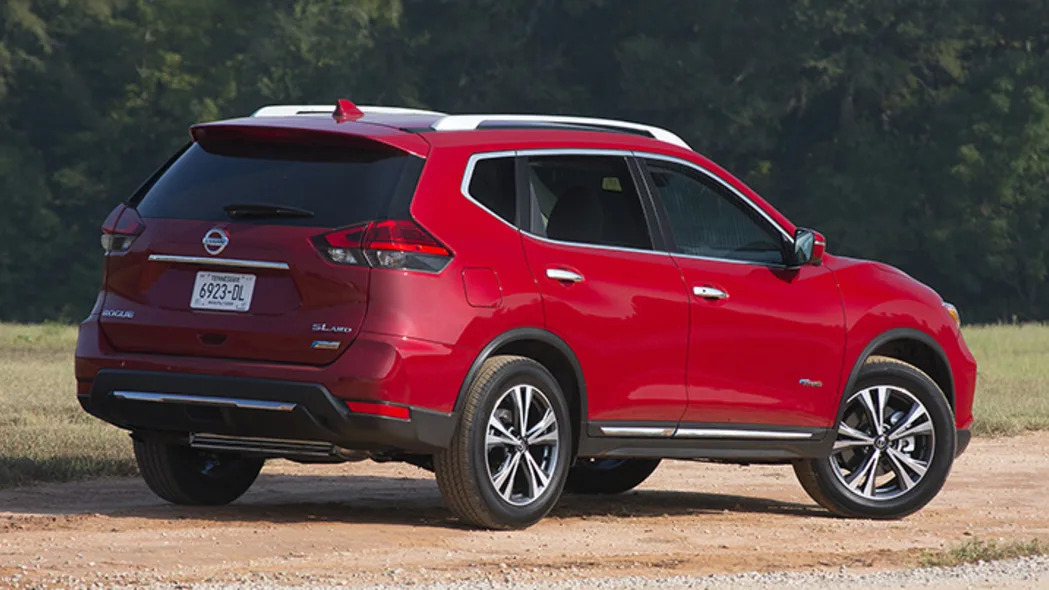
Because the Rogue Hybrid is identical to the standard car aside from a trio of "Pure Drive Hybrid" badges located on the front doors and tailgate, it remains inoffensively handsome. That might be an issue for people who want to make a statement with their green vehicle choice, but for us it's just fine.
The cabin is also mostly a carryover from the standard car. The Hybrid has the refinements that were added to the gas-powered Rogue's cabin for 2017, so it's not a bad place to spend some time, although there are some sacrifices. On the aesthetic front, Nissan isn't offering the gas-powered model's lovely tan Platinum Reserve interior on the Rogue Hybrid. And utility takes a small hit, as the rear-mounted battery pack cuts down on cargo space. With the second row up and slid all the way back, the Hybrid offers 27.3 cubic feet of space to the standard car's 32, while max volume is down from 70.0 to 61.4 cubic feet.
Nissan hasn't released pricing for the Rogue Hybrid yet. It will be available in two models, skipping the standard Rogue's S base trim and moving directly to the mid-grade SV, with the SL, shown here, at the top of the food chain. The SL offers a number of desirable features, including LED headlights, heated leather seats, a motion-activated tailgate, a nine-speaker Bose stereo, and a heated steering wheel. Fully loaded, it should ring up for around $35,000, which puts the top Rogue up against the $34,970 Toyota RAV4 Hybrid Limited without creeping too far beyond the gas-powered SL AWD's $32,250 starting price.
We we had high hopes for the Rogue Hybrid but left disappointed by the details. Compact crossovers and hybrid powertrains will be a very popular combination when gas prices inevitably creep back up, but this one needs more polish before it will appeal to a wide audience.
Related Video:
Okay, maybe we're not as big of fans of Nissan's compact crossover as we are of the Star Wars franchise, but the standard Rogue is plenty competent and is now more competitive with a refresh for 2017. That's why the new hybrid model – a first for this compact crossover – had us expecting a welcome addition to the lineup. It seemed like a can't-lose proposition, but instead it has us thinking more of the pod races, midichlorians, and wooden acting that dragged down the highly anticipated Star Wars reboot.
The Rogue Hybrid's stats aren't the problem. Nissan paired a 141-horsepower, 144-pound-foot 2.0-liter, naturally aspirated four-cylinder with a 30-kilowatt electric motor for net output of 176 hp. That's more power than the 2.5-liter gas-only model. It sounds great on paper.
The two-clutch hybrid system sounds nice, too. Fitting one clutch between the engine and the electric motor and another between the motor and the Xtronic continuously variable transmission lets the engine shut down during highway driving and while coasting. In the gas engine's stead, the electric motor and the quick-charging lithium-ion battery pick up the slack and yield improved fuel economy.

But the two clutches suffer from what we'll call bad directing. The Rogue Hybrid's constant cycling between the gas engine and electric motor brings the powertrain's disagreements to the forefront. By contrast, the gas-electric Rogue's only natural rival, the Toyota RAV4 Hybrid, uses a planetary gearset to seamlessly integrate engine and electric motor, making shifts in power source easy to ignore. You can't ignore the Rogue's juggling.
Dig into the throttle from a standstill, and a half-second later the electric motor and gas engine start squabbling about where the power should come from. At first it seems like a laggy throttle, but after a short while you realize the issue isn't as simple as poor throttle calibration – it feels like the engine and motor are reading different chapters of different books in different libraries. Once the Rogue gets around to moving, things improve.
The Rogue Hybrid's actual performance under load is pleasant. There's almost enough low-end torque to make up for the sluggish off-the-line behavior, and when you're hard on the throttle it provides similar performance to the standard model, despite the extra 200 pounds of hybrid powertrain onboard. But back off, and things go to pieces again.




Sure, the hybrid system is geared toward returning good fuel economy – Nissan estimates RAV4-besting highway and combined ratings. But it does this by shutting off the engine at every constant-throttle opportunity it gets. Cruising on a country lane? Engine off. Freeway slog? Engine off again. Crawling through a neighborhood? You guessed it. The electric motor picks up the slack in light-throttle situations – the Rogue Hybrid will run on electric power alone at up to 75 miles per hour or for two full minutes at 25 mph – but digging deeper into the throttle forces the gas engine to fire up again.
This is typical hybrid behavior, but the Rogue's execution lacks polish. In the RAV4, you barely notice this happening. When you step on the gas in the Rogue, the lack of activity makes it seem like there is something wrong. There isn't – it's just the powertrain trying to figure out what the driver wants. If Nissan could speed up the four-cylinder's restart procedure, that might improve things. But as it stands, the constant sensation of being left flatfooted is annoying and, initially, worrying.
As with any hybrid, this Rogue uses regenerative braking to recapture energy, and it's here we observe an issue that we also noted with the Pathfinder Hybrid's brakes: they're grabby and difficult to modulate. Like with the Pathfinder, the unnatural reactions aren't a deal breaker – especially relative to the powertrain issues – but other automakers have managed to find a better balance between brake regen and modulation.




But there's that fuel economy again. Depending on how the numbers shake out in EPA testing, the Rogue could be the most fuel-efficient compact crossover from a mainstream automaker, a title currently held by the all-wheel-drive-only RAV4 Hybrid's 32-mile-per-gallon combined rating (34 city and 30 highway). Nissan estimates the front-drive Rogue Hybrid will return 33 mpg city and 35 highway for a 34-mpg combined rating. All-wheel drive drops those figures to 31, 34, and 33, respectively. So yes, the Rogue would barely win, but not when comparing the all-wheel-drive models.
We will of course admit that Episode I wasn't without its redeeming qualities, and that's true of the Rogue Hybrid. But unlike the stunning visuals in The Phantom Menace that set it apart from the original Star Wars trilogy, everything good about the Rogue Hybrid is present on the standard, gas-powered car.
The continuously variable transmission, for example, is as here agreeable as it is in the non-hybrid Rogue. It's smooth and competent, and once the hybrid system figures out where the power should come from, the CVT does its job well.
The ride and handling character are virtually unchanged, too, as the suspension is basically carryover. The hybrid is comfortable and quiet, and perfectly par for the course in this segment. After driving it back-to-back with the standard model, we barely noticed the impact of the Rogue Hybrid's low-rolling-resistance tires or the extra 200 pounds of electric motor and batteries stowed on board. The Rogue isn't a sharp, pointy dancing partner to begin with, but adding the hybrid components also doesn't make it into an ungainly mess, which is sometimes the case with cars that see this type of powertrain transformation.

Because the Rogue Hybrid is identical to the standard car aside from a trio of "Pure Drive Hybrid" badges located on the front doors and tailgate, it remains inoffensively handsome. That might be an issue for people who want to make a statement with their green vehicle choice, but for us it's just fine.
The cabin is also mostly a carryover from the standard car. The Hybrid has the refinements that were added to the gas-powered Rogue's cabin for 2017, so it's not a bad place to spend some time, although there are some sacrifices. On the aesthetic front, Nissan isn't offering the gas-powered model's lovely tan Platinum Reserve interior on the Rogue Hybrid. And utility takes a small hit, as the rear-mounted battery pack cuts down on cargo space. With the second row up and slid all the way back, the Hybrid offers 27.3 cubic feet of space to the standard car's 32, while max volume is down from 70.0 to 61.4 cubic feet.
Nissan hasn't released pricing for the Rogue Hybrid yet. It will be available in two models, skipping the standard Rogue's S base trim and moving directly to the mid-grade SV, with the SL, shown here, at the top of the food chain. The SL offers a number of desirable features, including LED headlights, heated leather seats, a motion-activated tailgate, a nine-speaker Bose stereo, and a heated steering wheel. Fully loaded, it should ring up for around $35,000, which puts the top Rogue up against the $34,970 Toyota RAV4 Hybrid Limited without creeping too far beyond the gas-powered SL AWD's $32,250 starting price.
We we had high hopes for the Rogue Hybrid but left disappointed by the details. Compact crossovers and hybrid powertrains will be a very popular combination when gas prices inevitably creep back up, but this one needs more polish before it will appeal to a wide audience.
Related Video:










Sign in to post
Please sign in to leave a comment.
Continue